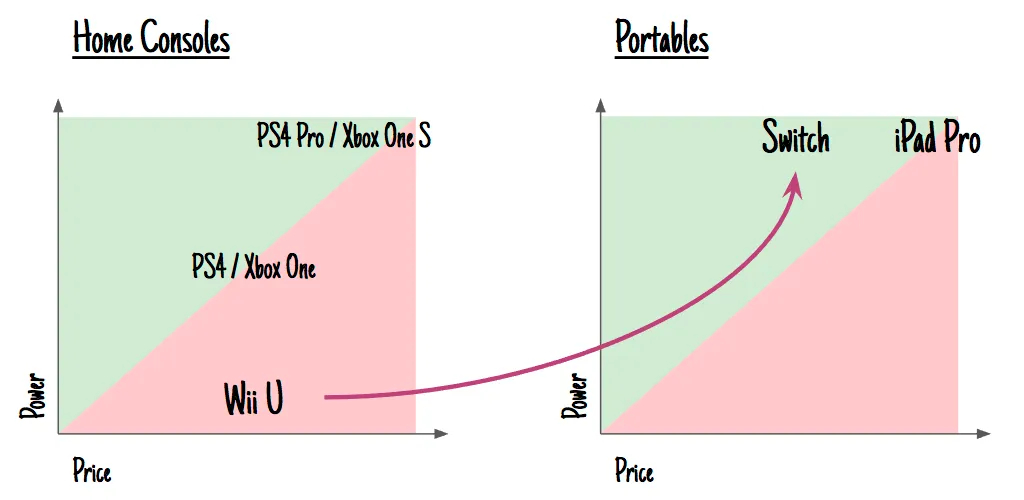 Tom Greenaway
Tom Greenaway
About me
Works

Hi – my name's Tom and I like making things.
Receive updates on my latest games, experiments and thoughts.
"You cannot follow us here".
Nintendo has a long history of innovation in hardware. Since its start in video game consoles they have innovated in hardware alongside their software offerings.
The SNES added shoulder buttons which enabled more simultaneous inputs (thumbs + fingers) from users. The N64 was the first 4 player ready console and invented the analog stick. The Wii made a splash with motion control. The Wii U added a tablet interface.
Meanwhile, the PlayStation 1 followed the SNES with shoulder buttons. The PlayStation multi-tap added 4 players to the PS1 and PS2. The original XBox launched 4 player ready. Sony created the Dual Analog Controller mid-cycle for the PS1. Later, the Kinect and PSMove added their own visions of motion control to chase the Wii. And for a time, Sony and Microsoft discussed the potential of “second screen interfaces” via tablets — but stopped once the Wii U was revealed to be a dud.
Can you spot the trend? Hardware can be highly innovative and act as a unique selling point. However, the success is often short lived as competitors can easily copy hardware features either the generation after (Xbox and 4 player input) or mid-generation (Multi-tap and PSMove). Wherever Nintendo went the other consoles could and often did follow.
The Wii was a tremendous success due to its motion control interface and the resulting casual gaming boom it attracted. In that generation Nintendo did what Nintendo does best. They created a unique piece of hardware and built games that integrated heavily with said hardware.
So what went wrong with the Wii U? Unsurprisingly, innovation for the sake of innovation isn’t enough. The innovation must create a compelling new feature. Motion control was compelling. A tablet that is chained to your house is not. Even when it was announced the Wii U seemed like a confusing concept — a mobile-like tablet interface that isn’t portable?
At a glance, the Switch seems to be just a better implementation of the Wii U concept. Or is it?
On the surface level, the Switch is another attempt at an innovative user interface for video game consoles. Just like the Wii U, it’s a tablet screen interface. Considering the popularity of smartphones and tablet devices this isn’t a terrible area to experiment in video game interfaces for Nintendo.
However, there is more innovation here than simply a new hardware interface. In fact, looking through the lens of the interface it’s clear that the Switch isn’t very different to the Wii U and that neither is really very different to mobile tablets such as the iPad. So should we expect the Switch to succeed where the Wii U failed? The answer is yes, but not because of the interface.
The Switch will succeed because it repositions the home console as a hybrid portable. Finally, a hardware feature that cannot be copied by the competition. Sony and Microsoft both chase the “arms race” of power in their consoles — the best CPU, the best GPU, the best RAM, etc. This entire strategy is totally orthogonal to the strategy of portability.
Therefore Sony and Microsoft can’t copy Nintendo and expand their feature set to encompass the Switch’s unique selling point. In fact, Nintendo has moved the battlefield of its console into a space they have long dominated — the handheld dedicated gaming device.

Note: Graphs are relative. I’m not suggesting that the Switch is as powerful as the PS4 Pro.
Sure, modern smartphones have completely outsold the Gameboy and Nintendo DS. But when it comes to analysing just the handheld dedicated gaming device market — Nintendo is king.
With iPad and tablet sales waning. More and more F2P smartphone games requiring active internet connections (including Super Mario Run!). And the Switch being $100+ cheaper than an iPad. Perhaps the Switch will cement itself as the best device for a road trip — or plane trip.
It’s dangerous to go alone take… the Switch.
Article published on: 17 Mar, 2017